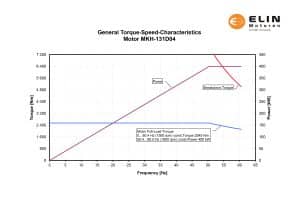As summer slowly draws to a close, many of us look back on our grilling escapades – the sizzling successes and the occasional burnt mishaps. Just like that perfectly grilled steak, an electric motor needs to be operating at its prime for optimal results. But here’s the catch – much like a steak cooked too quickly or for too long, an extrusion line, injection molding machine, or mixer system can face trouble if its electric motor isn’t hitting the sweet spot. An electric motor that does not operate at the optimum operating point affects the quality of the end product, the required energy demand, and, as a result, the energy costs. In the worst case, this can also damage the whole plant.
This blog article explains why the duty point for electric motors in plastics processing is essential for maximum motor efficiency and performance. But what is the optimum operating point, and how does it affect the overall system?
The optimum operating point is the operating point at which the motor works most effectively. It then runs neither too fast nor too slow but at precisely the right speed and load. Working too quickly or overloaded can cause overheating and damage the motor and the equipment. Working too slowly, on the other hand, could be less efficient and waste energy. It is, therefore, crucial to match the motor’s rated point to the equipment’s operating point as closely as possible.

Saving costs and energy
To save costs and energy, finding the optimum nominal point for an electric motor on an extruder, injection molding machine, or mixer system is essential. For this, the engine must operate in such a way that it achieves its maximum output without being overloaded. First, you must determine the equipment’s operating cycle or work process. To calculate the optimum rated point of the motor, you must know both the maximum power and the required torque to calculate the optimum operating point using a load profile. The closer the system’s operating point is to the rated point of the electric motor, the better. The torque curve of the electric motor plays an important role here. It shows how much power the motor delivers at different speeds and can be presented in the form of a table or as a graph.
Influences on the optimum operating point
The optimum operating point of electric motors on plastic processing equipment, such as an extrusion line, is influenced by several factors. These include:
- Type of material being extruded
- Speed of extrusion
- Inner diameter of the die
- Outer diameter of the pipe
- Coolant system used
The type of extruded material affects both the force required and the temperature necessary to ensure optimum processing. The extrusion speed is another factor, as it is critical to the mechanical forces and heat generation. The die’s inside diameter and the pipe’s outside diameter determine the quality of the extruded material. Finally, the choice of cooling method is also essential to regulate the temperature and protect the motor from overheating. Each of these factors influences the motor’s required force and cooling temperature for optimal processing.
“We understand that the heart of motor performance lies in the precision of the optimum operating point. Guided by our expertise, we fine-tune electric motors to hit this crucial chord – a matter of balance where efficiency, longevity, and output blend harmoniously”, says Christoph Gögele, Director Business Division Mining and Plastics at ELIN Motoren. “Our customers can trust in a solution that conducts cost savings, energy efficiency, and product quality in perfect unison.”

At ELIN Motoren, we have decades of experience in the development of electric motors, and our technical experts will be happy to assist you in calculating the optimum operating point of your electric motor to save costs and energy and ensure the quality of the end products.

